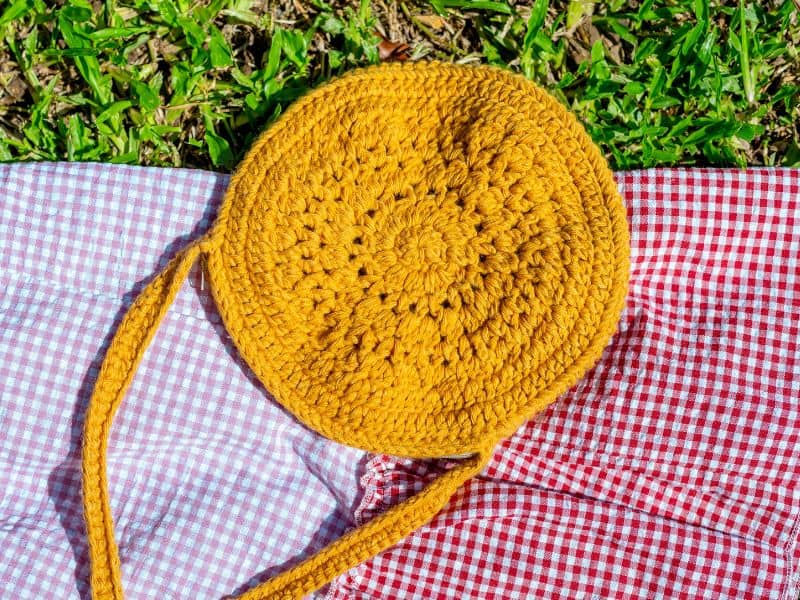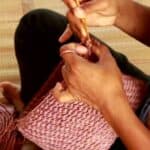With a plethora of stitches, patterns, and techniques to master, it’s essential to start with the fundamentals. One of the best ways to build a strong foundation in crochet is by learning to create basic shapes. We will explore the easiest shapes to crochet, along with tips and project ideas, to help you master the basics.
The easiest shape to crochet is the rectangle, as it requires simple stitches like single crochet, double crochet, or half-double crochet, and consists of repetitive rows, making it perfect for beginners to master basic skills while creating items like scarves, dishcloths, or blankets.
When making a rectangle, it’s important to keep your stitch count accurate by adding or decreasing in each new row. The next easiest shape is the circle. It can be crocheted using either an adjustable loop or a series of chain stitches as the starting point.
Let’s take a closer look at some easy shape considerations.
Easy Shape Considerations
When selecting the easiest shape to crochet, several factors contribute to the overall simplicity and learning experience for beginners:
Stitch Simplicity
Basic stitches such as the single crochet (sc), double crochet (dc), and half-double crochet (hdc) are fundamental to mastering crochet. The easiest shapes incorporate these simple stitches, allowing beginners to learn and practice them without feeling overwhelmed.
Repetition and Pattern Recognition
Repetitive patterns are essential for beginners, as they allow for easier memorization and understanding of stitch sequences. Consistent repetition also helps improve muscle memory and overall crochet technique.
Ease of Customization
Simple shapes offer versatility, enabling beginners to personalize projects by adding colors, textures, or stitch variations. Experimenting with customization can boost confidence and creativity in crochet.
Project Versatility
Easy shapes serve as building blocks for various projects, from functional household items to fashionable accessories. Mastering these basic shapes allows for a seamless transition to more complex crochet creations.
The Easiest Shapes to Crochet
Rectangle
The rectangle is the simplest shape for beginners to crochet, requiring only foundational stitches.
- Single crochet stitch (sc): A compact stitch creating a dense fabric, ideal for sturdy projects.
- Double crochet stitch (dc): A taller stitch, providing a more open texture for lightweight items.
- Half-double crochet stitch (hdc): A versatile stitch, offering a balance between the sc and dc stitches.
Project ideas: scarves, dishcloths, blankets
Square
Squares are another beginner-friendly shape, with two popular types being the Granny square and Solid square.
- Granny square: A classic crochet pattern created by working in rounds, often with color changes for a vibrant design.
- Solid square: A square worked in rows or rounds, creating a uniform fabric with minimal gaps.
Project ideas: coasters, afghan squares, potholders
Circle
Circles, while slightly more advanced, offer a unique shape to crochet.
- Magic circle technique: A technique for starting a crochet circle, allowing for a tight center.
- Increasing stitches in the round: Essential for maintaining a flat circle, evenly distributing increases throughout each round.
Project ideas: coasters, appliques, ornaments
Triangle
Triangles, though not as straightforward as rectangles or squares, introduce increasing and decreasing stitches.
- Triangle motif: A symmetrical pattern typically worked in rows, forming a triangular shape.
- Increasing and decreasing stitches: Techniques used to expand or contract the fabric, shaping the triangle.
Project ideas: bunting, shawls, headbands
Tips for Mastering Basic Shapes
As you begin your crochet journey, consider these tips to help you master the fundamental shapes:
Start With a Foundation Chain
The foundation chain is the starting point for most crochet projects. Ensure that your chain is neither too tight nor too loose, as it affects the overall appearance and flexibility of the finished piece.
Use Stitch Markers for Easy Counting
Stitch markers can help you keep track of your stitches and rows, ensuring consistency throughout your work. This is especially useful when working in the round or when increasing and decreasing stitches.
Practice Tension Control
Consistent tension is crucial for even and professional-looking crochet. As you become more comfortable with the basic stitches, focus on maintaining consistent tension to improve the quality of your work.
Master the Art of Increasing and Decreasing Stitches
Increasing and decreasing stitches are essential techniques for shaping your crochet projects.
Practice these methods to create various shapes, such as circles and triangles, and expand your crochet repertoire.
Reading and Understanding Crochet Patterns
As you progress in your crochet journey, you’ll encounter various patterns that guide you through creating beautiful projects.
To help you navigate these patterns with ease, let’s explore common pattern abbreviations and symbols, tips for following written and charted patterns, and how to convert between US and UK terminology.
Common pattern abbreviations and symbols
Crochet patterns often use abbreviations and symbols to save space and simplify instructions.
Familiarizing yourself with these common terms will enable you to read and follow patterns more effectively:
- ch – chain
- sc – single crochet (US) / double crochet (UK)
- hdc – half-double crochet (US) / half-treble crochet (UK)
- dc – double crochet (US) / treble crochet (UK)
- tr – treble crochet (US) / double treble crochet (UK)
- sl st – slip stitch
- inc – increase
- dec – decrease
- rep – repeat
- … – repeat the instructions within the asterisks
Crochet charts use symbols to visually represent stitches and techniques. Each symbol corresponds to a specific stitch, making it easy to follow the pattern by looking at the chart.
Tips for following written and charted patterns
- Read the pattern carefully before beginning: Familiarize yourself with the stitches, techniques, and any special instructions or notes.
- Highlight or underline important information: Mark your size (if applicable) and any customizations you plan to make.
- Keep track of your progress: Use a row counter or make notes on the pattern to help you remember where you left off.
- Learn to “read” your crochet: Understand how different stitches look in your work so you can easily identify and correct mistakes.
- Practice with simple patterns first: Build your confidence and pattern-reading skills by starting with basic shapes and projects.
Expanding Your Crochet Skills
Once you have mastered the basic shapes, you can explore more complex projects and techniques:
Combining Shapes for More Complex Projects
Combine rectangles, squares, circles, and triangles to create intricate patterns and designs. For example, join multiple Granny squares to create a stunning afghan or connect triangles for a geometric shawl.
Exploring New Stitches and Techniques
Experiment with different stitches and techniques, such as cables, lace, or bobbles, to add texture and dimension to your projects. This will enhance your crochet skills and enable you to tackle more advanced patterns.
Joining Online Crochet Communities for Inspiration and Support
Connect with fellow crocheters through online forums, social media groups, or video tutorials. These communities offer a wealth of inspiration, advice, and support, helping you grow and develop your crochet skills.
Frequently Asked Questions
The essential stitches for beginners to learn are single crochet (sc), double crochet (dc), and half-double crochet (hdc). These basic stitches are used in a wide variety of crochet projects.
Repetition is crucial when learning crochet as it helps to develop muscle memory and improve overall crochet technique. Additionally, repetitive patterns are easier to memorize and understand for beginners.
Consistent tension is essential for creating even and professional-looking crochet projects. Poor tension control can result in uneven stitches and an inconsistent fabric appearance.
Project ideas for beginners using the rectangle shape include scarves, dishcloths, and blankets.
A Granny square is a classic crochet pattern created by working in rounds, often with color changes for a vibrant design, whereas a Solid square is worked in rows or rounds, creating a uniform fabric with minimal gaps.
Conclusion
In conclusion, mastering the basic shapes in crochet – rectangles, squares, circles, and triangles – is the first step towards building a strong foundation in this delightful craft. As you progress in your crochet journey, remember that practice and patience are key to refining your skills and tackling more complex projects.
Embrace the challenge, experiment with customization, and connect with fellow crocheters to share inspiration, advice, and support. By starting with the simplest shapes and gradually expanding your repertoire, you’ll be well on your way to creating beautiful, functional, and personalized crochet projects with confidence and joy.






